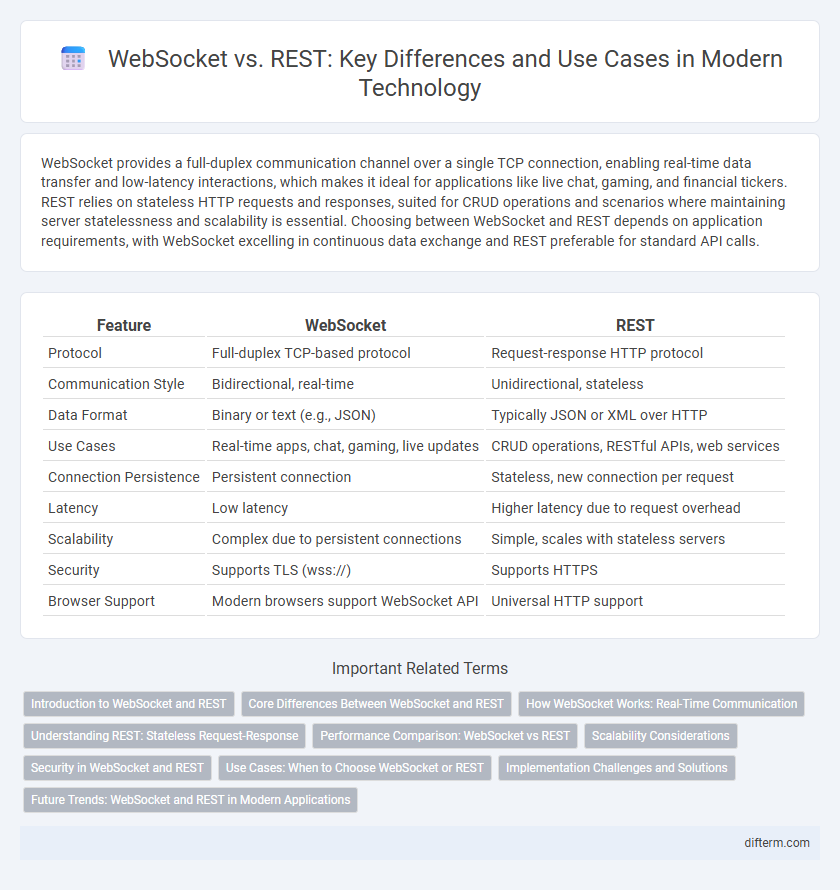WebSocket provides a full-duplex communication channel over a single TCP connection, enabling real-time data transfer and low-latency interactions, which makes it ideal for applications like live chat, gaming, and financial tickers. REST relies on stateless HTTP requests and responses, suited for CRUD operations and scenarios where maintaining server statelessness and scalability is essential. Choosing between WebSocket and REST depends on application requirements, with WebSocket excelling in continuous data exchange and REST preferable for standard API calls.
Table of Comparison
| Feature | WebSocket | REST |
|---|---|---|
| Protocol | Full-duplex TCP-based protocol | Request-response HTTP protocol |
| Communication Style | Bidirectional, real-time | Unidirectional, stateless |
| Data Format | Binary or text (e.g., JSON) | Typically JSON or XML over HTTP |
| Use Cases | Real-time apps, chat, gaming, live updates | CRUD operations, RESTful APIs, web services |
| Connection Persistence | Persistent connection | Stateless, new connection per request |
| Latency | Low latency | Higher latency due to request overhead |
| Scalability | Complex due to persistent connections | Simple, scales with stateless servers |
| Security | Supports TLS (wss://) | Supports HTTPS |
| Browser Support | Modern browsers support WebSocket API | Universal HTTP support |
Introduction to WebSocket and REST
WebSocket is a communication protocol providing full-duplex channels over a single TCP connection, enabling real-time data exchange between clients and servers. REST (Representational State Transfer) is an architectural style that allows stateless client-server interactions using standard HTTP methods such as GET, POST, PUT, and DELETE. Both WebSocket and REST are integral to web technologies, with WebSocket suited for continuous, low-latency communication and REST ideal for stateless, request-response operations.
Core Differences Between WebSocket and REST
WebSocket enables real-time, full-duplex communication between client and server, maintaining an open connection for continuous data exchange, while REST operates on a request-response model with stateless HTTP protocols. WebSocket is ideal for applications requiring instant updates like chat apps or live feeds, whereas REST suits traditional CRUD operations and resource-based interactions. Core differences include statefulness, connection persistence, and communication pattern, with WebSocket offering lower latency and bidirectional messaging compared to REST's one-way, stateless requests.
How WebSocket Works: Real-Time Communication
WebSocket establishes a persistent, full-duplex communication channel between a client and server over a single TCP connection, enabling real-time data exchange with minimal latency. Unlike REST, which relies on repeated HTTP requests, WebSocket streams bidirectional messages instantly, optimizing performance for interactive applications such as live chats, gaming, and financial tickers. This continuous connection reduces overhead and accelerates data transmission, enhancing user experience in time-sensitive environments.
Understanding REST: Stateless Request-Response
REST architecture principles emphasize statelessness, where each request from client to server must contain all necessary information to understand and process the request independently. This stateless request-response model enhances scalability by eliminating server-side session storage requirements, ensuring that each interaction is isolated. Web servers handling RESTful APIs respond with standard HTTP status codes and payloads, facilitating straightforward caching, load balancing, and fault tolerance.
Performance Comparison: WebSocket vs REST
WebSocket delivers superior performance over REST by enabling full-duplex communication, which reduces latency and enhances real-time data transfer. REST relies on stateless HTTP requests, introducing overhead with repeated connection setups and limiting responsiveness in dynamic applications. High-frequency trading platforms and multiplayer gaming systems benefit especially from WebSocket's efficient, low-latency data exchange compared to REST's request-response model.
Scalability Considerations
WebSocket offers superior scalability for real-time applications by maintaining persistent, full-duplex communication channels that reduce overhead and server load compared to REST's stateless request-response model. REST APIs excel in scalability for CRUD operations and stateless interactions, leveraging caching and load balancing effectively for high traffic scenarios. Choosing WebSocket benefits systems requiring low-latency message delivery at scale, while REST is optimal for scalable, resource-oriented architectures with predictable workloads.
Security in WebSocket and REST
WebSocket and REST handle security through distinct mechanisms tailored to their communication models. WebSocket employs TLS encryption (wss://) to secure data in transit, but it requires robust validation and authorization during the initial handshake to prevent vulnerabilities like cross-site WebSocket hijacking. REST leverages well-established HTTP security standards including HTTPS, OAuth, and JWT tokens, providing granular access control and stateless authentication that enhance security in distributed web services.
Use Cases: When to Choose WebSocket or REST
WebSocket is ideal for real-time applications such as live chat, gaming, and financial tickers where low latency and full-duplex communication are critical. REST remains preferable for stateless operations, CRUD (Create, Read, Update, Delete) functionality, and scenarios requiring scalability and easy caching, like traditional APIs and microservices. Choosing between WebSocket and REST depends on whether the application demands continuous, bidirectional communication or simple, request-response, stateless interactions.
Implementation Challenges and Solutions
Implementing WebSocket involves challenges such as maintaining persistent connections and handling real-time data flow, which require robust server infrastructure and efficient memory management. REST implementation faces difficulties in ensuring statelessness and managing complex state-dependent workflows through multiple HTTP requests, often solved by designing clear API endpoints and using caching strategies. Employing load balancers and protocol-specific libraries can mitigate scalability issues common to both WebSocket and REST architectures.
Future Trends: WebSocket and REST in Modern Applications
WebSocket is increasingly favored in modern applications for real-time communication due to its efficient, full-duplex protocol that reduces latency compared to REST's stateless architecture. REST remains popular for its simplicity, scalability, and wide compatibility, especially in microservices and CRUD operations. Emerging trends suggest hybrid models leveraging WebSocket for live data updates alongside REST for traditional API requests to optimize performance and user experience.
WebSocket vs REST Infographic

 difterm.com
difterm.com